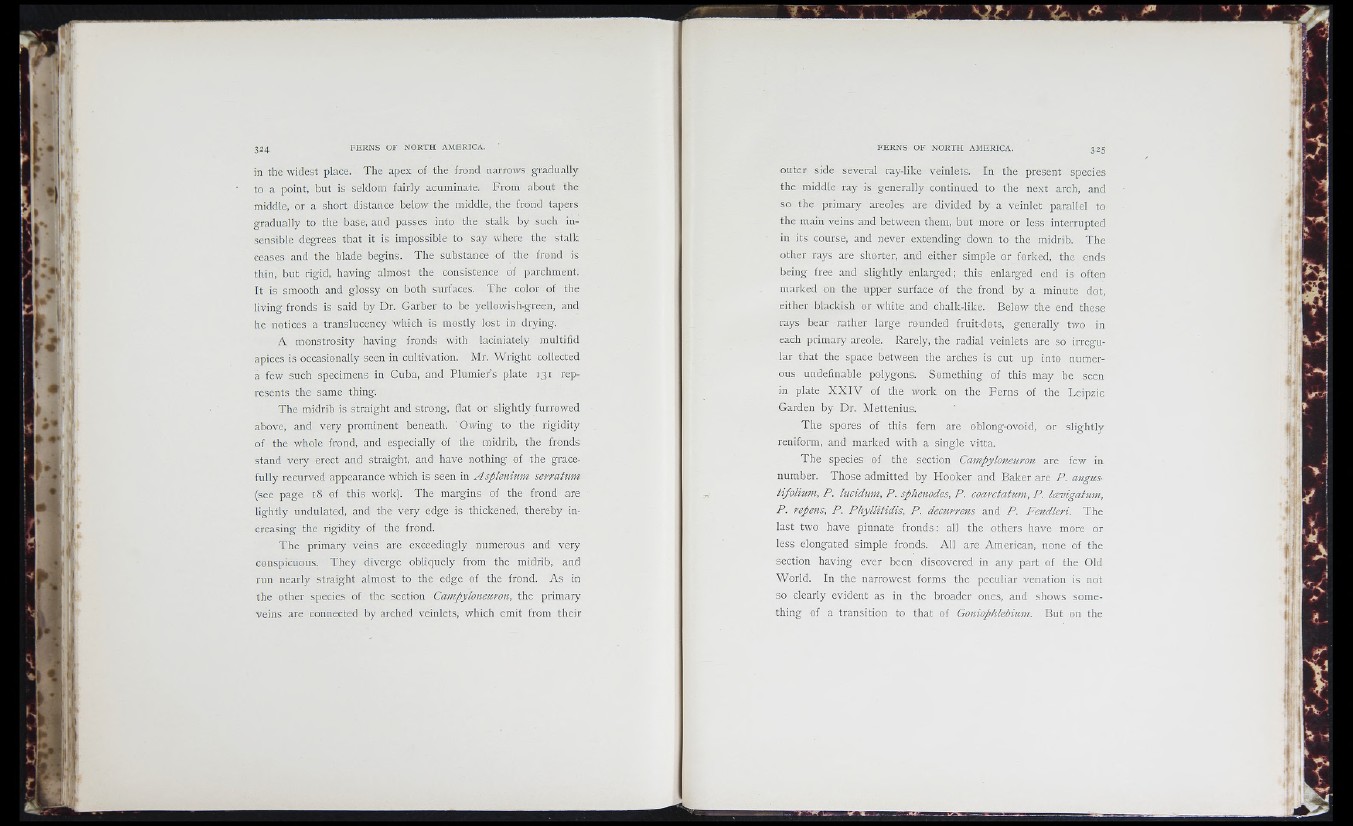
in the widest place. The apex of the frond narrows gradually
to a point, but is seldom fairly acuminate. From about the
middle, or a short distance below the middle, the frond tapers
gradually to the base, and passes into the stalk by such insensible
degrees that it is impossible to say where the stalk
ceases and the blade begins. The substance of the frond is
thin, but rigid, having almost the consistence of parchment.
It is smooth and glossy on both surfaces. The color of the
living fronds is said by Dr. Garber to be yellowish-green, and
he notices a translucency which is mostly lost in drying.
A monstrosity having fronds with laciniately multifid
apices is occasionally seen in cultivation. Mr. Wright collected
a few such specimens in Cuba, and Plumier’s plate 13 1 represents
the same thing.
The midrib is straight and strong, flat or slightly furrowed
above, and very prominent beneath. Owing to the rigidity
of the whole frond, and especially of the midrib, the fronds
stand very erect and straight, and have nothing of the gracefully
recurved appearance which is seen in Asplenium serratum
(see page 18 of this work). The margins of the frond are
lightly undulated, and the very edge is thickened, thereby increasing
the rigidity of the frond.
The primary veins are exceedingly numerous and very
conspicuous. They diverge obliquely from the midrib, and
run nearly straight almost to the edge of the frond. As in
the other species of the section Campyloneuron, the primary
veins are connected by arched veinlets, which emit from their
outer side several ray-like veinlets. In the present species
the middle ray is generally continued to the next arch, and
so the primary areoles are divided by a veinlet parallel to
the main veins and between them, but more or less interrupted
in its course, and never extending down to the midrib. The
other rays are shorter, and either simple or forked, the ends
being free and slightly enlarged; this enlarged end is often
marked on the upper surface of the frond by a minute dot,
either blackish or white and chalk-like. Below the end these
rays bear rather large rounded fruit-dots, generally two in
each primary areole. Rarely, the radial veinlets are so irregular
that the space between the arches is cut up into numerous
undefinable polygons. Something of this may be seen
in plate X X IV of the work on the Ferns of the Leipzic
Garden by Dr. Mettenius.
The spores of this fern are oblong-ovoid, or slightly
reniform, and marked with a single vitta.
The species of the section Campyloneuron are few in
number. Those admitted by Hooker and Baker are P . angus-
tifolium, P. lucidum, P. sphenodes, P. coarctatum, P . Icevigatum,
P. repens, P . Phyllitidis, P. decurrens and P. Fendleri. The
last two have pinnate fronds: all the others have more or
less elongated simple fronds. All are American, none of the
section having ever been discovered in any part of the Old
World. In the narrowest forms the peculiar venation is not
so clearly evident as in the broader ones, and shows something
of a transition to that of Goniophlebium. But on the